Photogrammetric Documentation of the Hittite ‘Spring of Nerik’, Oymaağaç Höyük (Türkiye)—How Different Data Products Can Be Derived from Image Series
Abstract
1. Introduction
2. Materials and Methods
2.1. The Underground Structure
2.2. Finds of Waterlogged Wood
2.3. Photogrammetric Documentation
2.3.1. Multi-Image Acquisition
2.3.2. SfM Workflow
- Alignment (bundle adjustment and sparse point cloud);
- Multi-View Stereo (dense point cloud);
- 3D Meshing (surface model and texture).
2.3.3. Image Acquisition of the Underground Structure
2.3.4. Image Acquisition of the Waterlogged Wood
3. Results
3.1. Data Products
3.1.1. Topographic Map and Elevation Model
3.1.2. RGB Satellite Image of Oymaağaç-Vezirköprü, 2021
3.1.3. Elevation Model of Oymaağaç-Vezirköprü, 2021
3.1.4. Photographic vs. Photogrammetric Documentation
3.1.5. Synopsis of Excavations at Oymaağaç Höyük 2009–2019
3.1.6. Visualization of 3D Content as VR
- Open the link with your VR glasses https://tiny.one/nerik (accessed on 1 August 2025).
3.1.7. Visualization of 3D Content via 3D PDF Using Adobe Acrobat
- 3D PDF of the underground structure https://labor.bht-berlin.de/fileadmin/labor/photogrammetrie/2022/3d.pdf/Nerik_Unterird_Baukomplex_2016-2019N.pdf (data from 2016 and 2019)
- 3D PDF showing the excavation site https://labor.bht-berlin.de/fileadmin/labor/photogrammetrie/2022/3d.pdf/Nerik_Grabung_2016_09_25u27N.pdf (data from 25 and 27 September 2016)
3.1.8. Visualization of 3D Content via Web Browser Using Potree
- Follow the link to virtually explore the excavation at Oymaağaç Höyük https://geomedien.bht-berlin.de/photogrammetrie/potree/nerik_en.html (accessed on 1 August 2025).
3.1.9. Visualization of 3D Content via Web Browser Using YouTube
- Take a tour of the excavation on YouTube https://www.youtube.com/watch?v=LNbXUuglwl0 (accessed on 1 August 2025).
3.1.10. Visualization of 3D Content via Web Browser Using Babylon.js Viewer
- Textured 3D model (high resolution) https://geomedien.bht-berlin.de/photogrammetrie/babylon/nerik_1high_zerteilt.html
- Textured 3D model (low resolution) https://geomedien.bht-berlin.de/photogrammetrie/babylon/nerik_6ultralow_zerteilt.html
3.1.11. Section of the Underground Structure at Oymaağaç Höyük
3.1.12. Visualization of 3D Content as Physical 3D Print
4. Discussion
5. Conclusions
Author Contributions
Funding
Data Availability Statement
Acknowledgments
Conflicts of Interest
Abbreviations
| BHT | Berliner Hochschule für Technik |
| DSLR | Digital Single Lens Reflex (Camera) |
| FU Berlin | Freie Universität Berlin |
| GNSS | Global Navigation Satellite System |
| SfM | Structure from Motion |
| SIFT | Scale Invariant Feature Transform |
References
- Arbeitsbericht der Kampagne 2006 (Rainer M. Czichon). Available online: www.nerik.de/downloads/Oymaagac%20-%20Kampagne%202006%20-%20Arbeitsbericht.pdf (accessed on 10 January 2025).
- Yakar, J. Recent Contributions to the Historical Geography of the Hittite Empire; Mitteilungen der Deutschen Orient Gesellschaft: Berlin, Germany, 1980; Volume 112, pp. 75–94. [Google Scholar]
- Mielke, D.P. Unterirdischer Treppengang und Quellkammer. In Archäologische Forschungen am Oymaağaç Höyük/Nerik 2016–2018; Mitteilungen der Deutschen Orient Gesellschaft: Berlin, Germany, 2019; Volume 151, pp. 135–155. [Google Scholar]
- Czichon, R.M.; Mielke, D.P. Nassholzfunde aus der unterirdischen Quellkammer. In Archäologische Forschungen am Oymaağaç Höyük/Nerik 2016–2018; Mitteilungen der Deutschen Orient Gesellschaft: Berlin, Germany, 2019; Volume 151, pp. 155–160. [Google Scholar]
- Mielke, D.P. Ausgrabungen in der unterirdischen Quellkammer. In Archäologische Forschungen am Oymaağaç Höyük/Nerik 2019; Czichon, R.M., Mielke, D.P., Eds.; Mitteilungen der Deutschen Orient Gesellschaft: Berlin, Germany, 2020; Volume 152, pp. 157–189. [Google Scholar]
- Czichon, R.M.; Mielke, D.P. Bearbeitung der Nassholzfunde aus der unterirdischen Quellkammer. In Czichon and Mielke; Archäologische Forschungen am Oymaağaç Höyük/Nerik 2019; Mitteilungen der Deutschen Orient Gesellschaft: Berlin, Germany, 2020; Volume 152, pp. 179–187. [Google Scholar]
- Breuer, M.; Czichon, R.M.; Koch, M.; Lehmann, M.; Mielke, D.P. Photogrammetrische 3D-Dokumentation von Nassholzfunden aus Oymaağaç Höyük/Nerik (Provinz Samsun/TR). Restaur. Archäol. 2017, 10, 47–62. [Google Scholar]
- Czichon, R.M.; Klinger, J.; Breuer, P.; Eerbeek, J.; Fox, S.; Marinowva-Wolff, E.; Marquardt, H.; von der Osten-Woldenburg, H.; Reichmuth, S.; Riehl, S.; et al. Archäologische Forschungen am Oymaağaç Höyük/Nerik (?) in den Jahren 2007–2010; Mitteilungen der Deutschen Orient Gesellschaft: Berlin, Germany, 2011; Volume 143, pp. 169–250. [Google Scholar]
- Luhmann, T.; Robson, S.; Kyle, S.; Boehm, J. Close-Range Photogrammetry and 3D Imaging, 3rd ed.; De Gruyter: Berlin, Germany; Boston, MA, USA, 2020; 822p. [Google Scholar]
- Kähler, M.; Lehmann, M. Photogrammetrie. In Archäologische Forschungen am Oymaağaç Höyük/Nerik 2011–2015; Mitteilungen der Deutschen Orient Gesellschaft: Berlin, Germany, 2016; Volume 148, pp. 121–127. [Google Scholar]
- Pergande, M. Dokumentation von Holzfunden am Oymaağaç Höyük durch 3D-Modellierung. Bachelor’s Thesis, Beuth Hochschule für Technik Berlin-University of Applied Sciences, Berlin, Germany, 8 August 2019. [Google Scholar]
- Breuer, M.; Lehmann, M.; Koch, M. Photogrammetrie. In Archäologische Forschungen am Oymaağaç Höyük/Nerik 2016–2018; Mitteilungen der Deutschen Orient Gesellschaft: Berlin, Germany, 2019; Volume 151, pp. 178–186. [Google Scholar]
- Lowe, D.G. Object Recognition from Local Scale-Invariant Features. In Proceedings of the Seventh IEEE International Conference on Computer Vision, Kerkyra, Greece, 20–27 September 1999; Volume 2, pp. 1150–1157. [Google Scholar]
- Schütze, M. Photogrammetrische Aufnahme eines Unterirdischen Ganges auf der Archäologischen Ausgrabung in Oymaağaç (Türkei). Bachelor’s Thesis, Beuth Hochschule für Technik Berlin-University of Applied Sciences, Berlin, Germany, 17 September 2017. [Google Scholar]
- Lux, H.F. Auswertung von Erfahrungen bei Entwicklung und Praktischem Einsatz eines Messwagens zur Photogrammetrischen Aufnahme von Nasshölzern. Bachelor’s Thesis, Berliner Hochschule für Technik-University of Applied Sciences, Berlin, Germany, 22 August 2024. [Google Scholar]
- Dowman, I.; Jacobsen, K.; Konecny, G.; Sandau, R. High Resolution Optical Satellite Imagery, 2nd ed.; Whittles Publishing: Dunbeath, UK, 2022; p. 271. [Google Scholar]
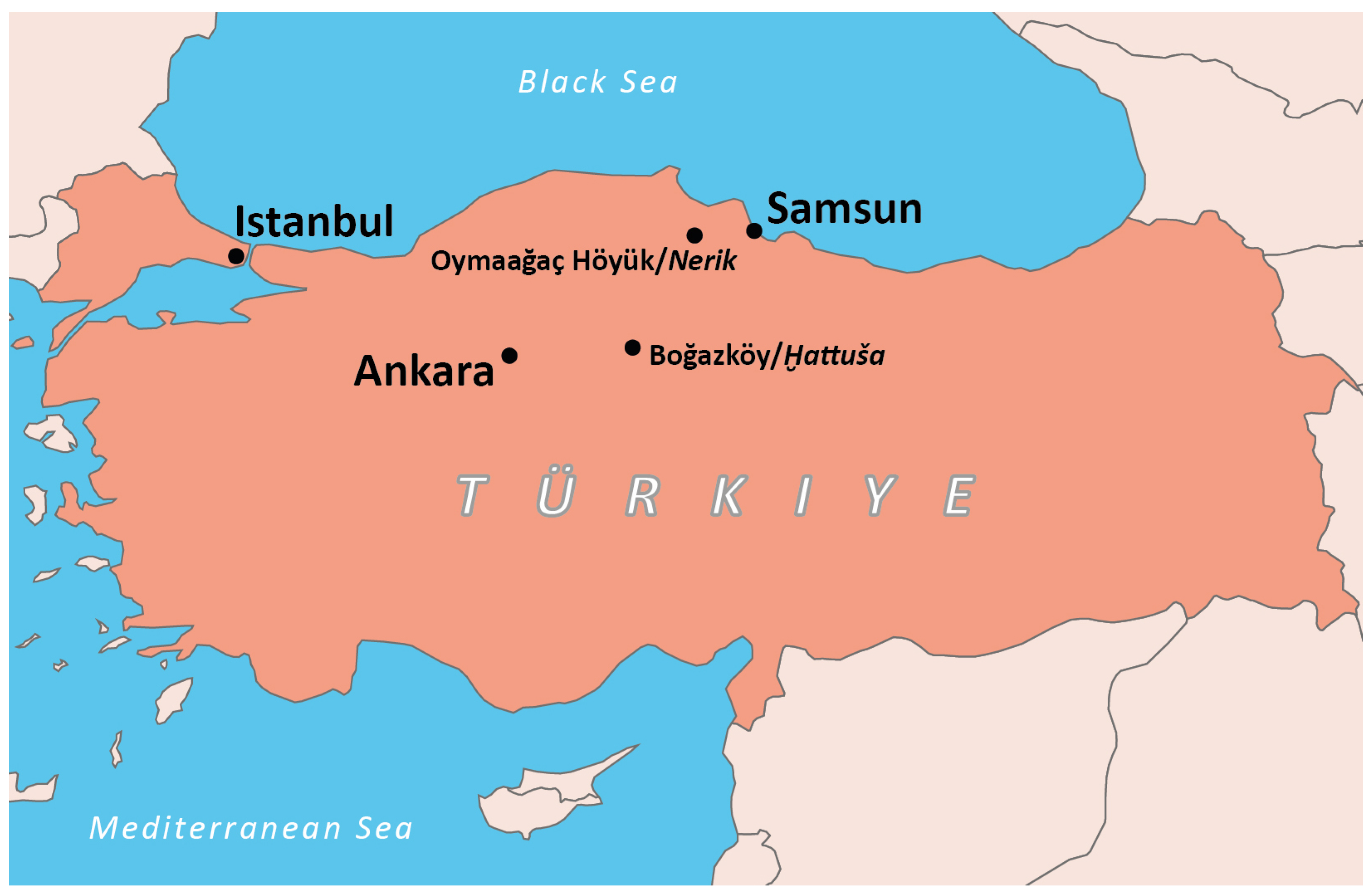


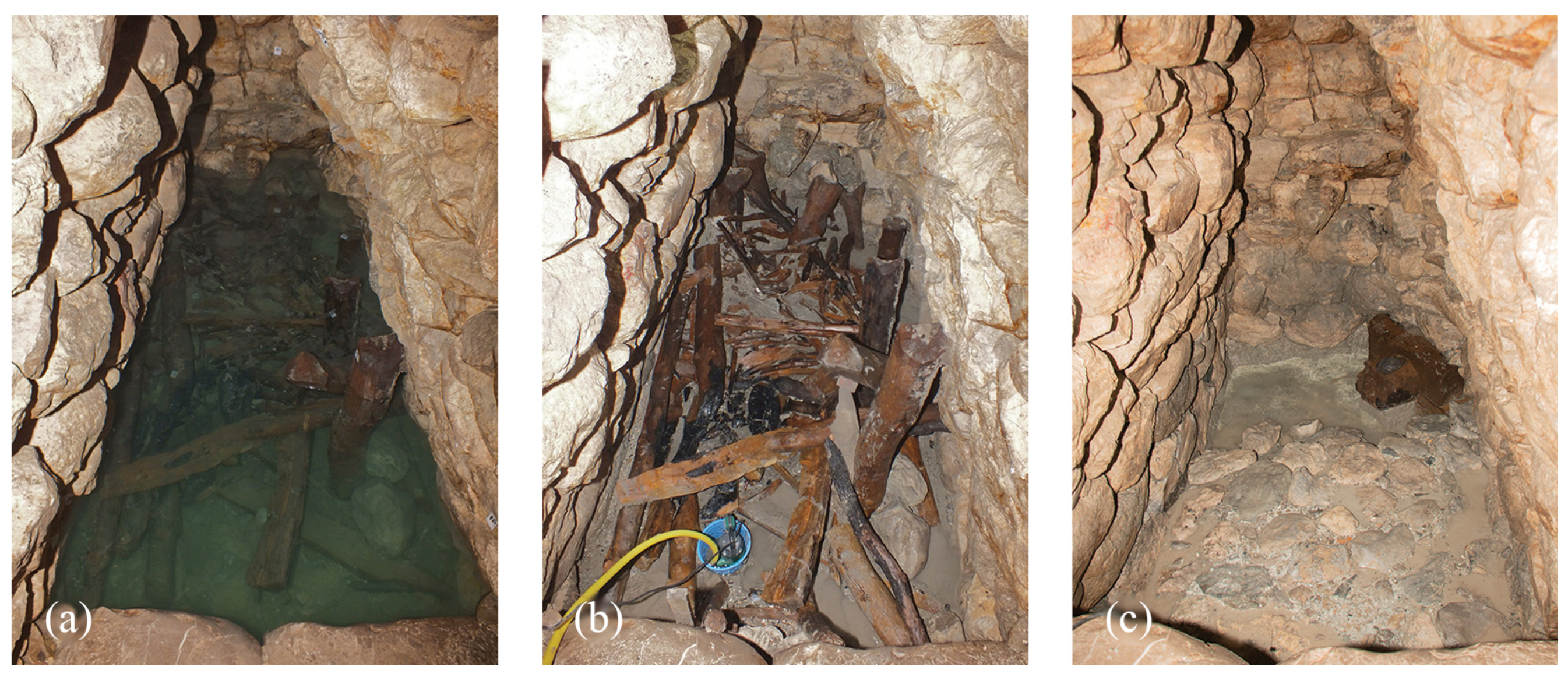

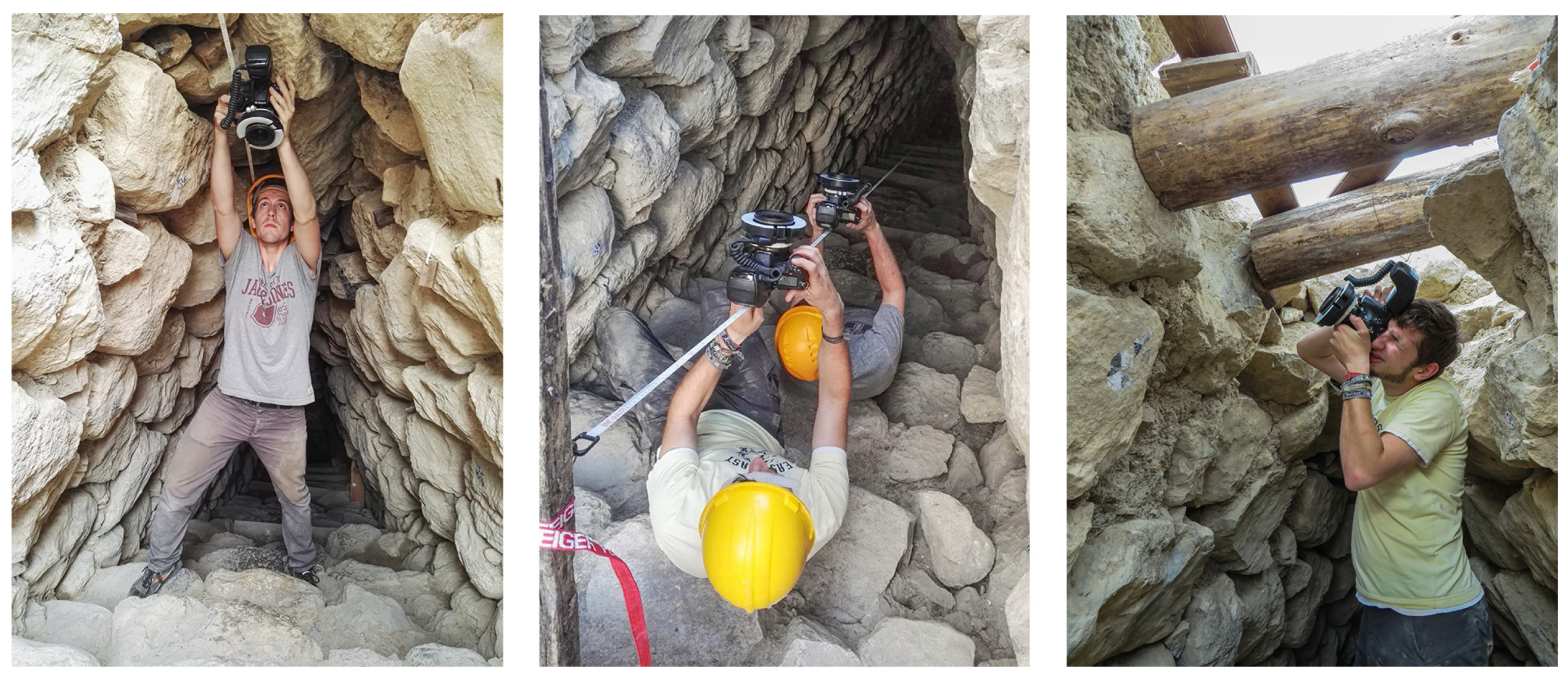

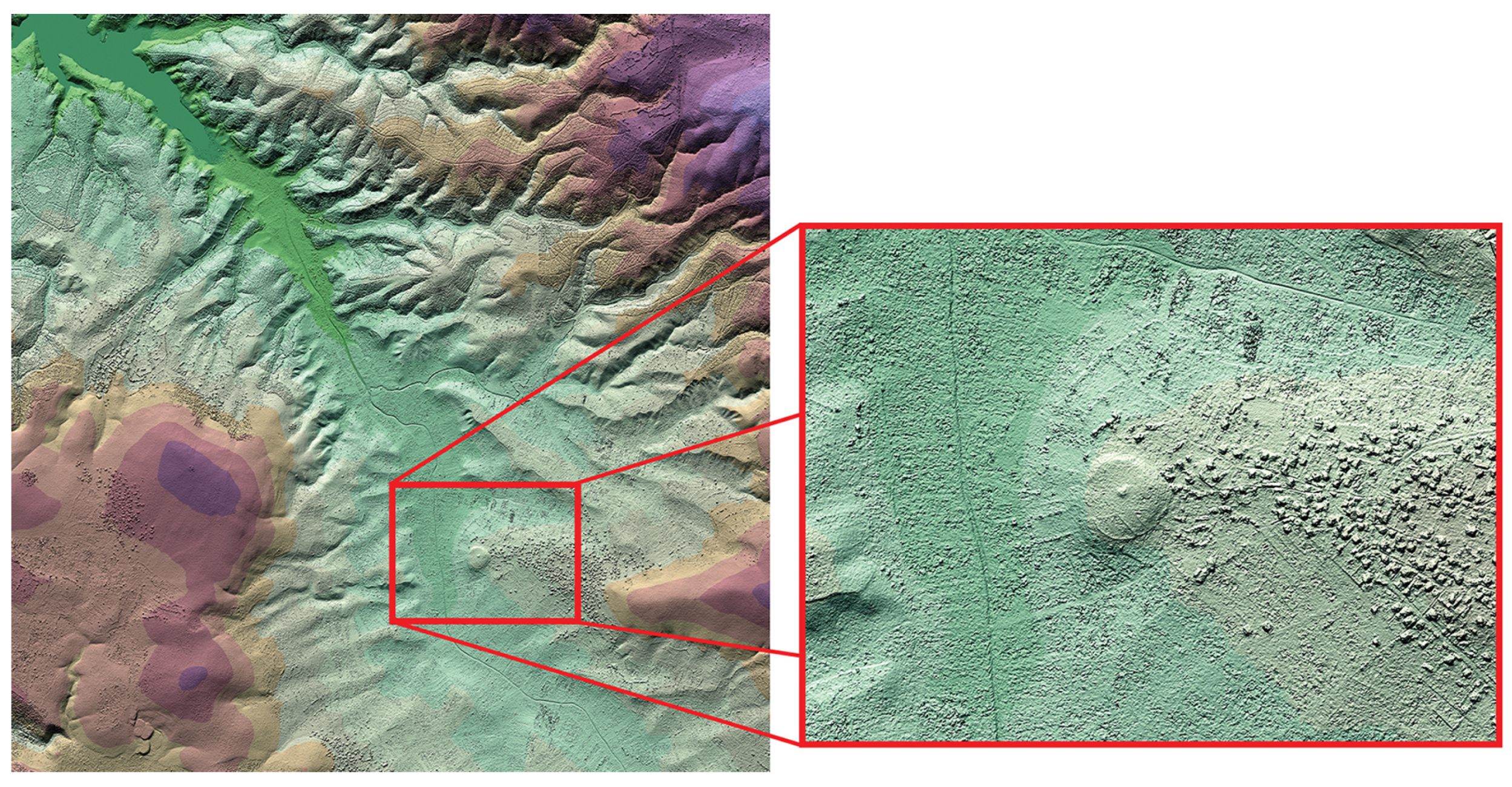
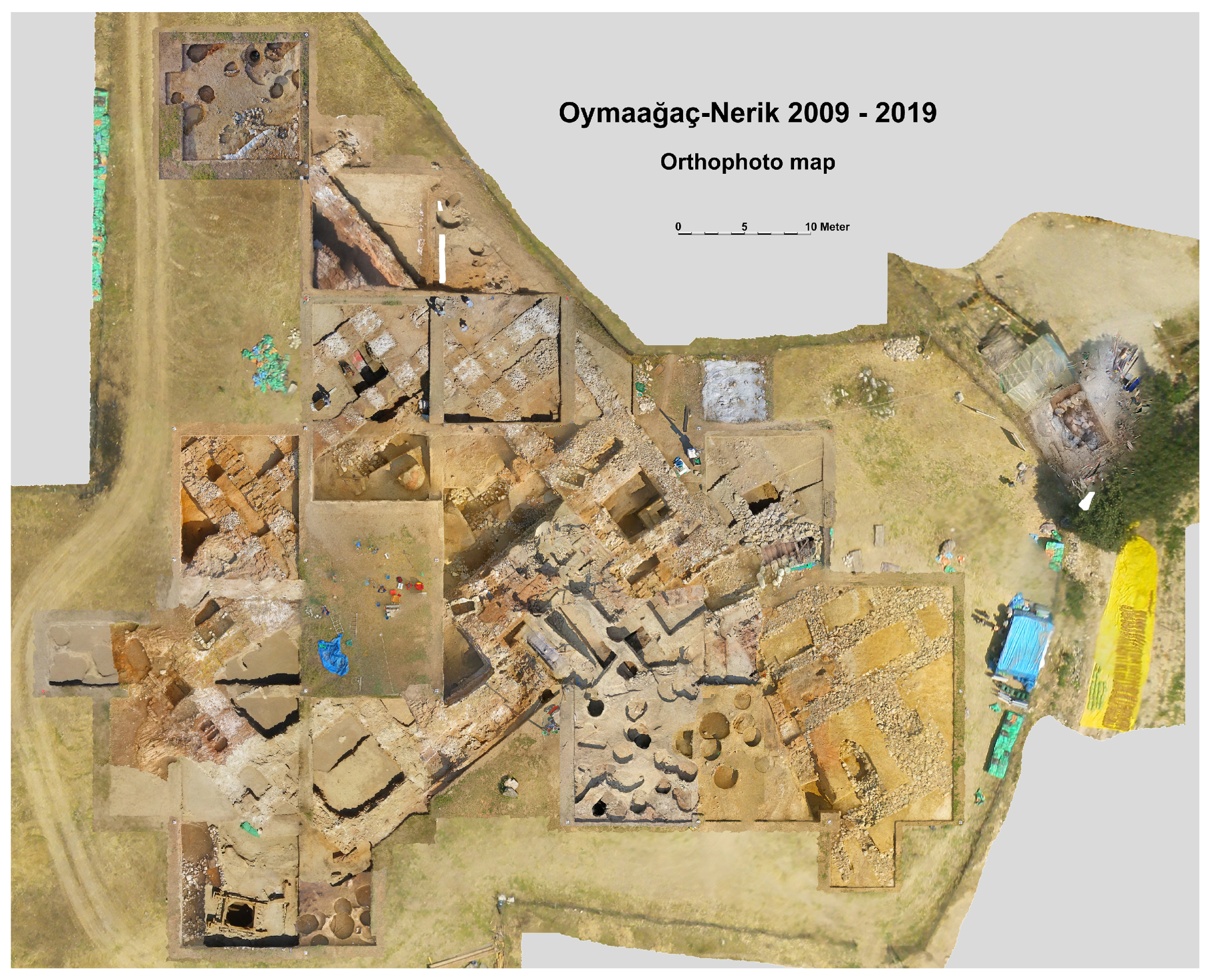
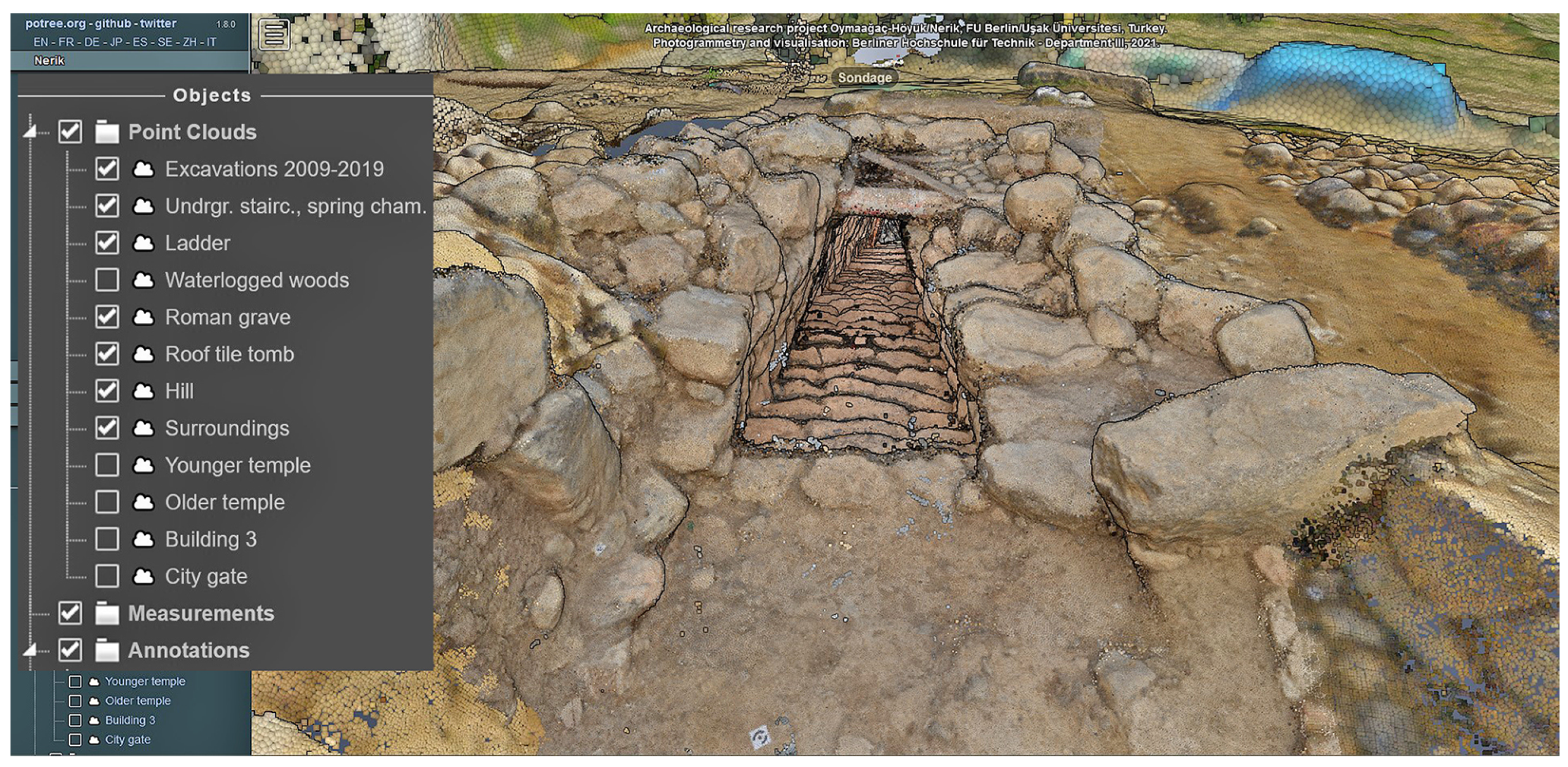

Disclaimer/Publisher’s Note: The statements, opinions and data contained in all publications are solely those of the individual author(s) and contributor(s) and not of MDPI and/or the editor(s). MDPI and/or the editor(s) disclaim responsibility for any injury to people or property resulting from any ideas, methods, instructions or products referred to in the content. |
© 2025 by the authors. Licensee MDPI, Basel, Switzerland. This article is an open access article distributed under the terms and conditions of the Creative Commons Attribution (CC BY) license (https://creativecommons.org/licenses/by/4.0/).
Share and Cite
Breuer, M.R.; Czichon, R.M.; Koch, M.; Lehmann, M.; Mielke, D.P. Photogrammetric Documentation of the Hittite ‘Spring of Nerik’, Oymaağaç Höyük (Türkiye)—How Different Data Products Can Be Derived from Image Series. Heritage 2025, 8, 322. https://doi.org/10.3390/heritage8080322
Breuer MR, Czichon RM, Koch M, Lehmann M, Mielke DP. Photogrammetric Documentation of the Hittite ‘Spring of Nerik’, Oymaağaç Höyük (Türkiye)—How Different Data Products Can Be Derived from Image Series. Heritage. 2025; 8(8):322. https://doi.org/10.3390/heritage8080322
Chicago/Turabian StyleBreuer, Michael Robert, Rainer Maria Czichon, Marko Koch, Monika Lehmann, and Dirk Paul Mielke. 2025. "Photogrammetric Documentation of the Hittite ‘Spring of Nerik’, Oymaağaç Höyük (Türkiye)—How Different Data Products Can Be Derived from Image Series" Heritage 8, no. 8: 322. https://doi.org/10.3390/heritage8080322
APA StyleBreuer, M. R., Czichon, R. M., Koch, M., Lehmann, M., & Mielke, D. P. (2025). Photogrammetric Documentation of the Hittite ‘Spring of Nerik’, Oymaağaç Höyük (Türkiye)—How Different Data Products Can Be Derived from Image Series. Heritage, 8(8), 322. https://doi.org/10.3390/heritage8080322






